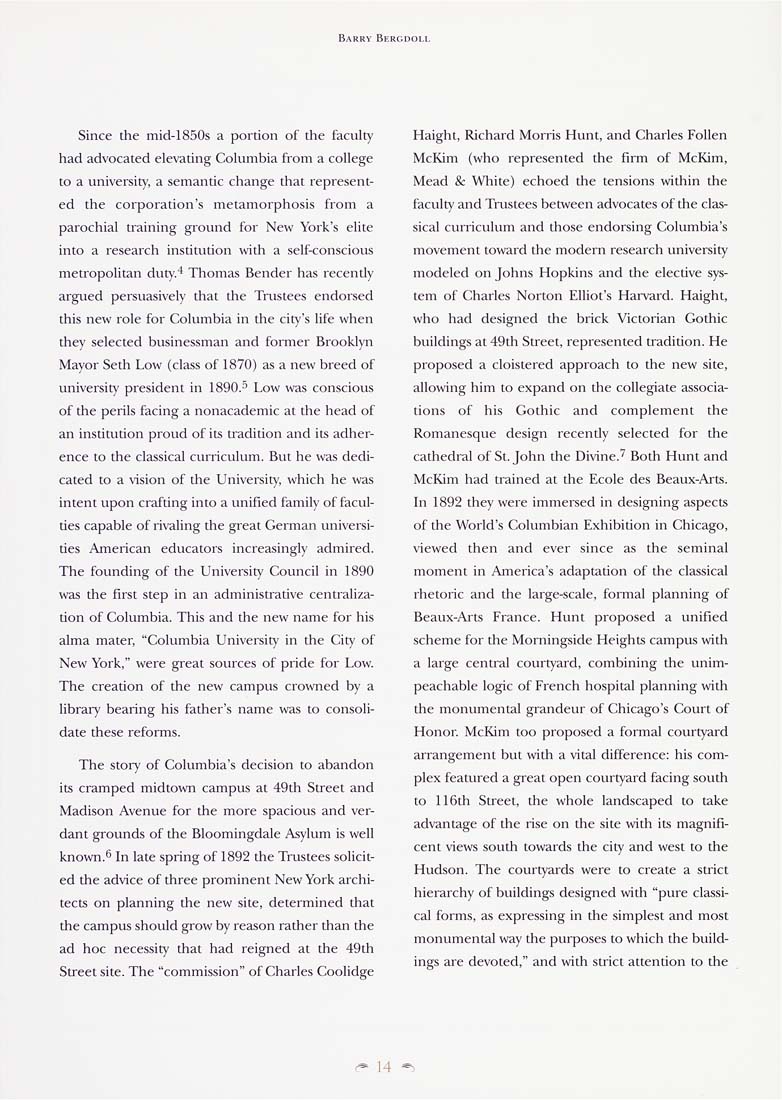Columbia Library columns (v.44(1995))
(New York : Friends of the Columbia Libraries. )
|
||
|
|
|
|
| v.44,no.2(1995:Autumn): Page 14 |

Barry Bergdoll Since the mid-1850s a portion of the faculty had advocated elevating Columbia from a college to a university, a semantic change that represent¬ ed the corporation's metamorphosis from a parochial training ground for New York's elite into a research institution with a self-conscious metropolitan dut)'."* Thomas Bender has recently argued persuasively that the Trustees endorsed this new role for Columbia in the city's life when they selected businessman and former Brooklyn Mayor Seth Low (class of 1870) as a new breed of university president in 1890.^ Low was conscious of the perils facing a nonacademic at the head of an institution proud of its tradition and its adher¬ ence to the classical curriculum. But he was dedi¬ cated to a vision of the University, which he was intent upon crafting into a unified family of facul¬ ties capable of rivaling the great German universi¬ ties American educators increasingly admired. The founding of the University Council in 1890 was the first step in an administrative centraliza¬ tion of Columbia. This and the new name for his alma mater, "Columbia University in the City of New York," were great sources of pride for Low. The creation of the new campus crowned by a library bearing his father's name was to consoli¬ date these reforms. The story of Columbia's decision to abandon its cramped midtown campus at 49th Street and Madison Avenue for the more spacious and ver¬ dant grounds of the Bloomingdale Asylum is well known.^ In late spring of 1892 the Trustees soUcit- ed the advice of three prominent New York archi¬ tects on planning the new site, determined that the campus should grow by reason rather than the ad hoc necessity that had reigned at the 49th Street site. The "commission" of Charles Coolidge Haight, Richard Morris Hunt, and Charles Follen McKim (who represented the firm of McKim, Mead & White) echoed the tensions within the faculty and Trustees between advocates of the clas¬ sical curriculum and those endorsing Columbia's movement toward the modern research university modeled on Johns Hopkins and the elective sys¬ tem of Charles Norton Elliot's Harvard. Haight, who had designed the brick Victorian Gothic buildings at 49th Street, represented tradition. He proposed a cloistered approach to the new site, allowing him to expand on the collegiate associa¬ tions of his Gothic and complement the Romanesque design recently selected for the cathedral of St John the Divine.' Both Hunt and McKim had trained at the Ecole des Beaux-Arts. In 1892 they were immersed in designing aspects of the World's Columbian Exhibition in Chicago, viewed then and ever since as the seminal moment in America's adaptation of the classical rhetoric and the large-scale, formal planning of Beaux-Arts France. Hunt proposed a unified scheme for the Morningside Heights campus with a large central courtyard, combining the unim¬ peachable logic of French hospital planning with the monumental grandeur of Chicago's Court of Honor. McKim too proposed a formal courtyard arrangement but with a vital difference: his com¬ plex featured a great open courtyard facing south to 116th Street, the whole landscaped to take advantage of the rise on the site with its magnifi¬ cent views south towards the city and west to the Hudson. The courtyards were to create a strict hierarchy of buildings designed with "pure classi¬ cal forms, as expressing in the simplest and most monumental way the purposes to which the build¬ ings are devoted," and with strict attention to the f^ 14 ^ |
| v.44,no.2(1995:Autumn): Page 14 |







